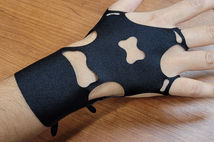top of page

Haptic Glove for Directional Feedback
Soft Robotics | Mechanical Engineering
As part of the Morphable Biorobotics Lab’s research on magnetically jammed haptics, I led the mechanical design and fabrication of a lightweight wearable glove integrating electropermanent-magnet (EPM)–based jamming units for tactile communication. The glove was used in human-subject trials and is featured in the IEEE RA-L publication “Jamming Metal Sheets Using Electropermanent Magnets for Stiffness Modulation.” It provides instantaneous, untethered haptic cues through localized stiffening of flexible magnetic elements, enabling passive, low-power feedback for robot-to-human interfaces
Technical Implementation
The glove was laser-cut from elastic fabric, allowing fabrication in 2-D and automatic shaping when worn. Controlled laser parameters and dampened cloth layers prevented thermal damage and preserved flexibility. Each haptic module consisted of a miniature EPM mounted over a stack of 1 cm-diameter steel disks, sewn directly into the fabric structure. Modules were spaced across the dorsal hand in four compass-like positions (north, south, east, west) to provide clear, directional tactile cues.
I developed the full fabrication workflow: pattern design, fabric testing, laser cutting, sewing of housings, and assembly of EPM–steel stacks. The design minimized bulk and wiring, producing a glove that covered only essential areas of the hand, improving comfort and wearability.
Key Challenges
Textile Processing: Power and speed calibration during laser cutting avoided melting or fraying of elastic material.
Ergonomics: Reducing surface coverage meant the glove no longer wrapped around fingers or palm areas unnecessarily, significantly improving comfort and freedom of movement.
Cue Localization: Increasing the spacing between modules ensured directional cues were perceptually distinct without requiring active calibration.
Evaluation
Ten participants performed blind directional-cue recognition tasks (N, S, E, W). After a brief training phase, the glove achieved 94.7 % mean accuracy, with several participants reaching 100 %, confirming the reliability of the mechanical design and tactile clarity
Paper
bottom of page







